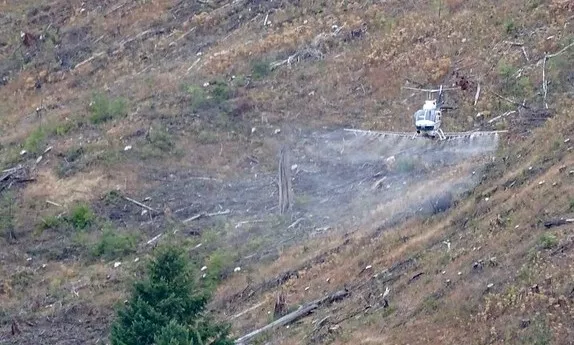
Seneca Lumber Company aerial spraying chemicals on their clearcut.
Photo credit: Francis Eatherington
The Oregon timber industry’s practice of spraying herbicides — all of them dangerous to humans, fish and animals — has been deeply controversial for decades. Studies show that up to 40 percent of the pesticides sprayed onto forestland by helicopters is blown off course from its targets.
In many cases, the toxic sprays — used by the timber industry to kill insects, weeds and vegetation in areas that have been clear cut — land on or near homes, farms, streams and lakes.
These pesticides, which include triclopyr, chlorpyrifos, Diuron and 2,4-D (one of the so-called “Agent Orange” chemicals), have been linked to a host of diseases and health issues, including respiratory problems, liver and kidney damage, miscarriages, and cancer.
In one particularly egregious October 2013 incident, toxic chemicals landed on more than 40 people in the Cedar Valley, in Curry County, seriously sickening many.
These problems were first documented in the classic exposé “A Bitter Fog” by Carol Van Strum. Many thousands of pounds of pesticides are sprayed on forestland throughout Oregon every year, though actual numbers are not published due to lack of reporting requirements.
Progress has been made in recent years, but much remains to be done. Here are some examples of incremental advances in the fight to end herbicide use in Oregon forestry under the recent Private Forest Accord:
- In early 2022, the EPA banned use of chlorpyrifos on food and feed crops, and starting Jan. 1, 2024, new Oregon Department of Agriculture rules will disallow most uses of the insecticide, including spraying on forestlands.
- In 2020, then-Governor Kate Brown helped catalyze the Private Forest Accord between some environmental groups and the timber industry. Later that year, that negotiation resulted in the Oregon Legislature passing Senate Bill 1602, which increased buffers for streams and improved the system for electronic reporting and notification of neighbors within a mile of areas to be sprayed by helicopters.
But those new rules did not require any reductions in the frequency or amounts of pesticides sprayed. Environmentalists and impacted communities want the practice significantly reduced or banned altogether, and the Oregon Chapter Sierra Club will continue to work for that change.
Learn more!
Join the Oregon Chapter Forest Team on Thursday, March 9th from 6PM-7:15 PM, for a webinar featuring Lisa Arkin of Beyond Toxics, a long-time advocate for ending aerial spraying in Oregon forestry. Register here.
You can also check out this short video: Herbicides in Oregon Waters.
To find out more about the Oregon Chapter Sierra Club’s Forest Team, contact Carol at illinoisvalley@oregon.sierraclub.org.